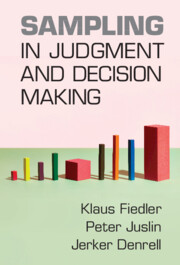Book contents
- Sampling in Judgment and Decision Making
- Sampling in Judgment and Decision Making
- Copyright page
- Contents
- Figures
- Tables
- Contributors
- Part I Historical Review of Sampling Perspectives and Major Paradigms
- Chapter 1 The Theoretical Beauty and Fertility of Sampling Approaches
- Chapter 2 Homo Ordinalus and Sampling Models
- Chapter 3 In Decisions from Experience What You See Is Up to Your Sampling of the World
- Chapter 4 The Hot Stove Effect
- Part II Sampling Mechanisms
- Part III Consequences of Selective Sampling
- Part IV Truncation and Stopping Rules
- Part V Sampling as a Tool in Social Environments
- Part VI Computational Approaches
- Index
- References
Chapter 1 - The Theoretical Beauty and Fertility of Sampling Approaches
A Historical and Meta-Theoretical Review
from Part I - Historical Review of Sampling Perspectives and Major Paradigms
Published online by Cambridge University Press: 01 June 2023
- Sampling in Judgment and Decision Making
- Sampling in Judgment and Decision Making
- Copyright page
- Contents
- Figures
- Tables
- Contributors
- Part I Historical Review of Sampling Perspectives and Major Paradigms
- Chapter 1 The Theoretical Beauty and Fertility of Sampling Approaches
- Chapter 2 Homo Ordinalus and Sampling Models
- Chapter 3 In Decisions from Experience What You See Is Up to Your Sampling of the World
- Chapter 4 The Hot Stove Effect
- Part II Sampling Mechanisms
- Part III Consequences of Selective Sampling
- Part IV Truncation and Stopping Rules
- Part V Sampling as a Tool in Social Environments
- Part VI Computational Approaches
- Index
- References
Summary
The threefold purpose of this initial chapter is to provide a review of the historical origins and the methodological beauty of sampling approaches to judgment and decision-making, to illuminate the most prominent recent developments, and to provide a preview of all chapters included in this volume. Accordingly, the chapter is organized into three parts. The historical review in the first part highlights the progress from purely intra-psychic to cognitive-ecological perspectives on adaptive cognition, conceived as a genuine interaction between environmental constraints and adaptive agents’ sampling strategies. The review of novel trends in the second part testifies to the fertility of sampling approaches and the impressive amount of progress it has inspired in terms of functional-level applications in various areas, but also in terms of mechanistic and computational modeling. A preview of all 22 chapters of the present volume in the final part is organized into six sections, covering the full spectrum of these innovative developments in rationality research during the last 15 years.
Keywords
Information
- Type
- Chapter
- Information
- Sampling in Judgment and Decision Making , pp. 3 - 34Publisher: Cambridge University PressPrint publication year: 2023
References
Accessibility standard: Unknown
Why this information is here
This section outlines the accessibility features of this content - including support for screen readers, full keyboard navigation and high-contrast display options. This may not be relevant for you.Accessibility Information
- 1
- Cited by
